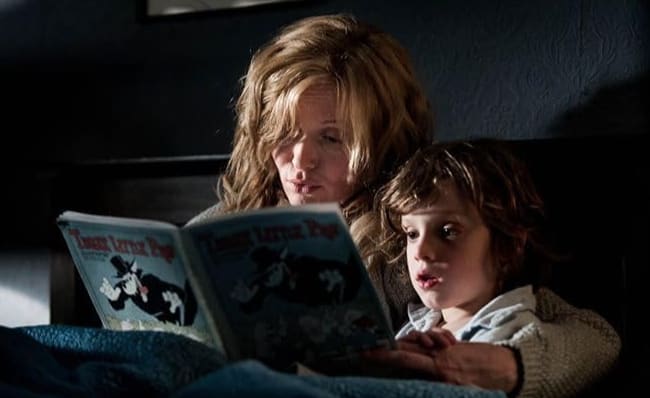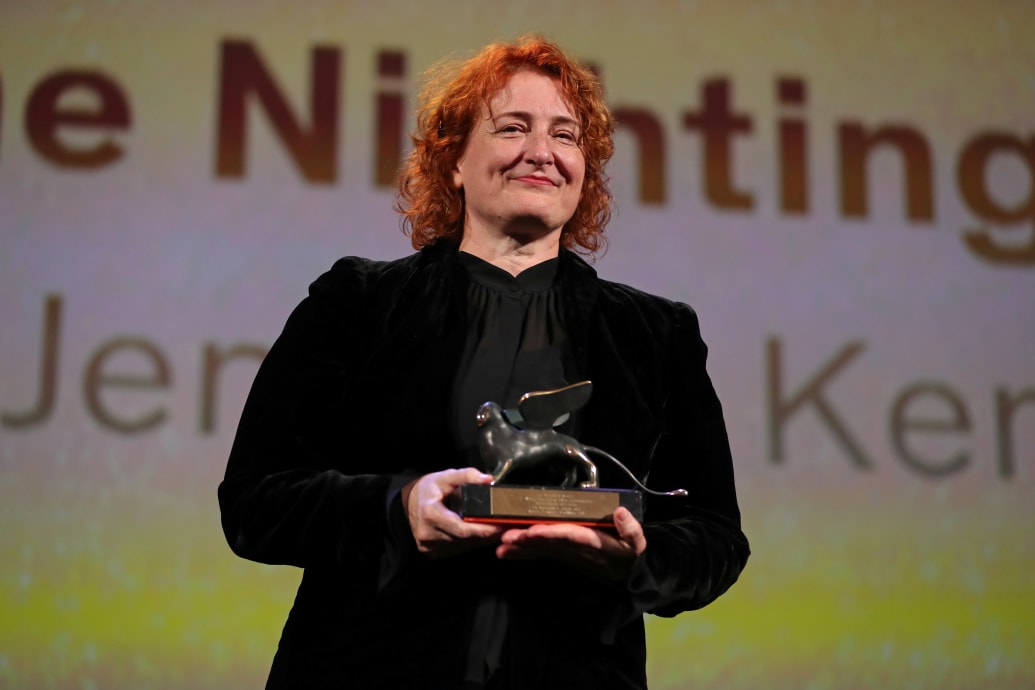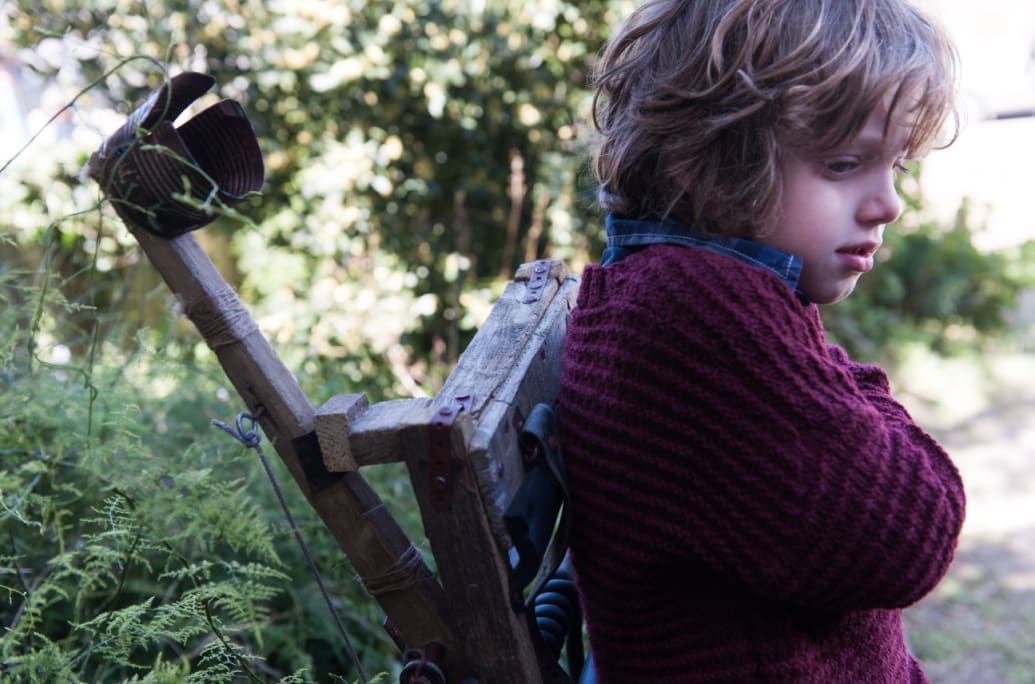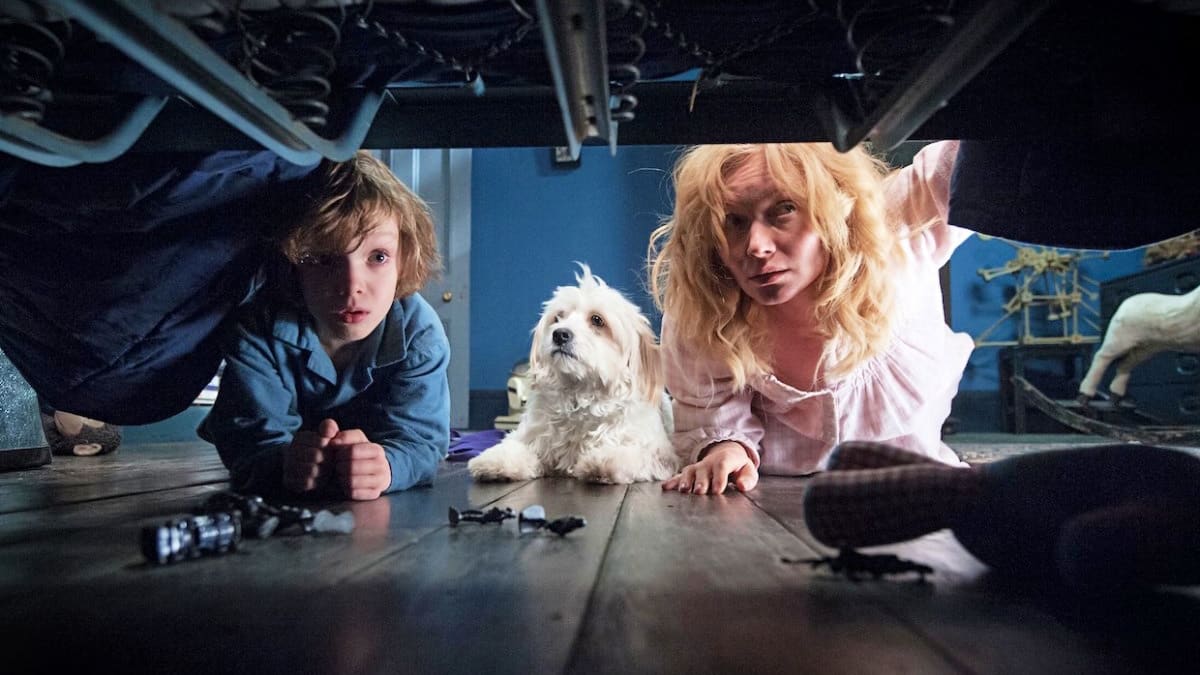“If it’s in a word, or it’s in a look, you can’t get rid of the Babadook,” goes the famous line in Jennifer Kent’s 2014 horror classic of that name. Ten years after its original release, though, The Babadook’s storybook rhyme needs updating: Today, it’s in sitcoms, reality TV competitions, and stop-motion sketch comedy shows, too. Like Amelia (Essie Davis) and her son, Samuel (Noah Wiseman), popular culture can’t get rid of the nattily-attired boogeyman; unlike mother and son, pop culture apparently likes keeping him around, if we go by the number of times he’s surfaced in unexpected places over the last decade.
IFCFilms and ICONIC Events are re-releasing The Babadook to commemorate its 10th anniversary, two months ahead of its premiere in U.S. theaters; the movie debuted worldwide at the Sundance Film Festival’s 2014 edition, and did the rounds at other fests until its November opening. This is great news for the folks who missed the film at the time, comprising “most” on account of the scant number of screens it played on—a sign of the times, predating the horror new wave that crested later in the decade and continues to roll over the industry in 2024. To watch The Babadook now is to witness the seismic event that stirred the wave.
Some viewers didn’t have the luxury of choice to see The Babadook in theaters in 2014; others did, but missed out either for lack of awareness or contemporaneous interest. Now, those viewers, whether longtime horror aficionados or recent converts, can count themselves among the film’s audience anew. That this recursive cycle is in keeping with the nature of the monster itself is a coincidental (but not unwelcome) bit of dovetailing detail.
In the movie, Amelia and Sam find themselves plagued by the Babadook after a pop-up book enumerating its pattern of predation appears on the boy’s bookshelf out of the blue; the creature slithers into its victims’ psyches and drives them mad, as Amelia discovers after reading the book to Sam. Kent’s German Expressionist aesthetic, in the monster’s design as well as the broader mise-en-scène, immediately distinguished The Babadook from its peers in 2014, and does so still, even after horror’s democratization and commercialization, which has always been democratic and commercial, has lifted it to new heights of appreciation while opening doors for new filmmakers keen on leaving their mark on the genre.

Jennifer Kent at the 2018 Venice Film Festival
Tony Gentile/Reuters
With The Babadook’s re-release imminent, we caught up with Kent to unpack the film’s lasting legacy.
There are two things I’m curious about now that we’re at the film’s 10th anniversary: How the text itself has changed and grown in that span of time, and the way the film has become a part of pop culture writ large. To start off with, I’m curious about how your relationship to the movie has changed since 2014.
It’s incredible that the film is being re-released on such a wide scale. From two screens in 2014 to 500 is incredible. I mean, no filmmaker expects that. You expect the other way, for the film to be forgotten. It’s really heartening to me. The reason why I make films, I think, is that you never know the life of it. You just have to make it, and then the life of it is up to the powers that be. I think for this film to be part of popular culture is just something you can’t ever predict or expect. I of course did not think that that would be the case; I just wanted to make this film and have as many people see it as we could get in the cinemas. So, yeah, it’s wonderful. It’s truly wonderful.
From your point of view, how have you seen the movie incorporate itself into horror? I don’t think there have been many straight up Babadook ripoffs, but I do think there’s been a good deal of references made to it [in horror movies]. How do you take those references and imitations?
I don’t tend to see that. I’m certainly not looking for it. I’m not thinking, “Oh, who’s ripping off my film?”, or, “Who’s taking from it?”, because I think film is a borrowed medium, and by that I mean, before I made The Babadook, I’d watched horror since I was a young kid, which is probably not advisable; my parents need a strict talking to. But I did, and I watched all of it, from Nosferatu onwards. I watched obscure silent horror. I watched everything. So The Babadook is a product of all of that going into me and my system and coming out hopefully as purely from me as I possibly could. It’s a medium where we are influenced by each other.
I can’t say that I wasn’t influenced by everyone that came before, you know, from Rosemary’s Baby and The Tenant to The Innocents to Italian horror—everything. I’m really happy that The Babadook, certainly in Australia, has made it easier for people to make horror films. I mean, I think people were going to make them anyway. But if the success of one film makes it easier for another filmmaker to make their film, great.

A photo still of The Babadook
Causeway Films
I don’t think you would have the horror genre if people weren’t borrowing from each other liberally all the time. In a way, though, is that different with The Babadook, because the theme is that this is a monster you can’t get rid of ? Again, if we look through the cannon over the last 10 years, we don’t see a ton of Babadook knockoffs. But in an industrial sense, it’s a forerunner to the [2010s horror boom]. You mentioned that it’s made it easier to make horror movies in Australia. How have you perceived the rising tide of horror, certainly in the U.S., but also globally since 2014?
I think what I’ve noticed is more confidence in the distribution of films that aren’t mainstream horror, and by mainstream, I mean they’re not a franchise. So, you can take a film that’s just good and scary and character based, and a company can get behind it and actually distribute it properly, so that it has a chance to do well, and then they do do well. So that’s what I’m noticing. I think the quality of horror has always been there. It’s just whether it’s seen or not.
And even when the quality isn’t there, if you’re a horror aficionado, you wind up digging through a ton of trash because that’s how you find the good stuff.
Yes, but I would argue that you have to dig through a ton of trash with drama as well, or comedy, or anything. It’s just that horror has this stigma attached to it. But when horror started out, all the best art house European directors directed horror, you know? It’s not a genre that doesn’t have its highs as well as its lows.
We’re definitely in a high period right now. There’s certainly the point of pride, in the case of The Babadook, of having been at the beginning of that high. We touched on this briefly at the start, but it must be a very different feeling to see the movie wriggle into shows like Grace and Frankie, You’re the Worst, The Magicians, Robot Chicken, What We Do in the Shadows, or, of course, the 2022 Scream reboot. That’s a separate phenomenon. Is that more surprising to you than the movie’s effect within horror movie culture?
Yeah, it’s a total surprise. How can you ever predict that? When I was making it, in fact, or before, we went to this workshop on how to market your film, which was put on by Screen Australia, or Screen New South Wales, or something at the time in Australia, and they were joking because they knew I was such a purist; they were saying, “Oh, we could have, Babadook trainers, and Babadook jackets!” I was like, oh no.
Funny enough, those would’ve sold well.
Well, they were taking the piss out of me, but when we made the book, I was so proud of that book that went out, and these cultural references, to me, it’s the icing on the cake. It’s amazing to be watching [a film or TV show], and suddenly see your film being referenced in it. It’s surreal, and I’ve loved it. I’m chuffed to see that.
Is there one in particular that won you over? For me, I love You’re the Worst’s commitment to including a Babadook joke in pretty much every single season.
I didn’t know it was in every season.
I may be wrong. It could just be three of the five seasons.
I saw the one where [Todd Robert Anderson] is saying, “Guys, it’s really scary!” as he’s being dragged out.
They did it again [in Season 4, with Colin Ferguson]! Is that the high for you, too?
The best one for me was RuPaul’s Drag Race.
Oh, I didn’t know they did it on that show!
I watched that religiously!

Jennifer Kent at the 2018 Venice Film Festival
Tony Gentile/Reuters
People who watch that show treat it like church, I’ve noticed.
Yeah, it’s my church. So to have a bunch of drag queens talking about your film is just heaven. [laughs] It’s fantastic. But the whole thing, it’s been great. I don’t quite understand it, and I’m totally going with it.
To me, it speaks not just to the fact that, obviously, people liked the film. It found its audience, maybe in spite of odds being against it. But I also think it speaks to the creature itself. What do you think the attraction is to the Babadook itself that draws people to it, whether it’s film, or TV, or LGBTQ+ culture adopting him as an icon?
I honestly don’t know. There’s a theatricality to the whole film, in that it was inspired by early horror, like The Cabinet of Dr. Caligari, Murnau’s Nosferatu, and Carl Theodor Dreyer—all of these films that have a theatricality to them by virtue of the time they were made. Or even the [Georges] Méliès films that pop up on the TV in The Babadook. All of that TV stuff was carefully orchestrated, but there’s a theatricality to the external part of it.
I also think we are always fascinated by our shadow side, by a part of ourselves that’s subterranean, and dark, and we relate to it. Is it a part of [Amelia] or is it removed from her? Who knows? It’s indefinable. I honestly can’t say this is why people are attracted to it; I’m just glad that they are. I’m glad they’re finding something from it.
What I can say as a filmmaker is, I personally feel it’s important to make films that speak to you as a filmmaker. Look, there’s all different types of films in the world and different types of filmmakers, but I can’t make a film unless I feel deeply for the subject matter. If you feel deeply for it, then there’s some slim chance that someone else will as well, and with The Babadook, I guess that’s what happened.
I wonder: How will he adapt to pop culture over the next 10 years? It’s so rare for that to happen.
You know, 10 years isn’t quite a generation, I guess. What is it, 15 years or so? But it’s time enough now for people to go out and see it who’ve never even heard of it or have vaguely heard of it, younger people who can go to the cinema now and see it.

A photo still from The Babadook
Causeway Films
I’ve been going to the cinema a lot here. There’s a cinematheque where I live, and they play old films for free. There’s nothing better than sitting in a cinema. I watched Dreyer’s Ordet, The Word, with a smaller group of people, but there comes a point in the film where it’s so devastating, but also wonderful, where I could hear people starting to cry throughout the cinema, including myself! You can’t beat this experience. We were all feeling this together, a
I saw 2001: A Space Odyssey last Friday night. It was packed. That film on TV? It’s OK. But in the cinema, that’s what it’s meant for. So for The Babadook to be replayed for people to be able to see it, it offers them another experience with the film that you cannot get at home. You just can’t.
What we’ve struck on now is a whole other thing that movie belongs to: Repertory culture. I saw 2001 in 70mm, and it completely blew me away. This is how movies like that and The Babadook get reintroduced to audiences over and over again. Now, it belongs to a particular class of movie that makes its way back into theaters every so often on the repertory circuit, too.
And talk about church! I mean, in my screening of 2001, there was some doofus at the back who started thinking it was funny to talk to the screen as if he was in his lounge room, and everyone just went, “Shhsh!” He got the big, the biggest shush you could imagine. People take it seriously because there’s a certain etiquette in the cinema that you must adhere to, or go home. You can’t be on your phone. You have to fully engage with it. That’s what’s brilliant about cinema being in a cinema.




![Tyson Foods Plant [Photo: Food Manufacturing]](https://southarkansassun.com/wp-content/uploads/2023/08/iStock_1185520857__1_.5e441daa51cca-600x337.jpg)








![Silverado Senior Living Management Inc. [Photo: Los Angeles Times]](https://southarkansassun.com/wp-content/uploads/2023/10/download-6-4-600x337.jpg)

![China's Wuhan Institute of Virology [Photo: Nature]](https://southarkansassun.com/wp-content/uploads/2023/09/d41586-021-01529-3_19239608-600x337.jpg)















